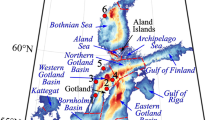Abstract
Based on all the available oceanological information (131 286 stations carried out from 1929 to 2020), for the first time for the Sea of Okhotsk, the spatial patterns of the upper boundary distribution parameters of the methane hydrate stability zone (water temperature, salinity, depth of the upper boundary in the water column) are presented and discussed. A model of the methane hydrate stability zone is considered. We revealed that the minimum water temperature and the minimum depth of the upper boundary of the gas hydrate stability zone (less than 1°C and 300–320 m, respectively) in the Sea of Okhotsk are located near the eastern slope of Sakhalin Island. The maximum water temperature and maximum depth of the upper boundary (1.5–1.7°C and 340–350 m, respectively) are characteristic of the area adjacent to the central and northern straits of the Kuril Islands Arc, as well as above the slope of the Kamchatka Peninsula. The salinity at the upper boundary of the methane hydrate stability zone in the Sea of Okhotsk varies within a narrow range from 33.4 to 33.6 psu, which is quite close to the conditions assume for the stability of methane hydrate in seawater. An area where the thermobaric conditions in the water column not favorable for the formation of methane hydrates has been identified.

Similar content being viewed by others
REFERENCES
Yu. F. Makogon, Geol. Polezn. Iskop. Mirovogo Okeana, No. 2, 5–21 (2010).
M. T. Reagan, G. J. Moridis, S. M. Elliott, and M. Maltrud, J. Geophys. Res. 116, C09014 (2011).
A. A. Trofimuk, N. V. Cherskii, and V. P. Tsarev, Dokl. Akad. Nauk SSSR 212 (4), 931–934 (1973).
Methane and Climate Changes: Scientific Problems and Technological Aspects, Ed. by V. G. Bondur, I. I. Mo-khov, and A. A. Makosko (Russ. Acad. Sci., Moscow, 2022) [in Russian].
V. I. Bogoyavlenskii, A. S. Yanchevskaya, I. V. Bogoyavlenskii, and A. V. Kishankov, Arktika: Ekol. Ekon., No. 3 (31), 42–55 (2018).
O. V. Veselov, V. V. Gordienko, and V. V. Kudel’kin, Geol. Polezn. Iskop. Mirovogo Okeana, No. 3 (5), 62–68 (2006).
Z. Chen, W. Bai, and W. Xu, Chin. J. Geophys. 48 (4), 936–945 (2005).
G. R. Dickens and M. S. Quinby-Hunt, Geophys. Rev. Lett. 21 (19), 2115–2118 (1994).
A. V. Eliseev, Fundam. Prikl. Klimatol. 1, 52–70 (2018).
V. Bogoyavlensky, A. Kishankov, A. Yanchevskaya, and I. Bogoyavlensky, Geosciences 8 (12), 453 (2018). https://doi.org/10.3390/geosciences8120453
D. F. McGinnis, J. Greinert, Y. Artemov, S. E. Beaubien, and A. Wuest, J. Geophys. Res. 111, C09007 (2006). https://doi.org/10.1029/2005JC003183
N. G. Granin, M. M. Makarov, K. M. Kucher, and R. Y. Gnatovsky, J. Geophys. Res. 30 (3-4), 399–409 (2010). https://doi.org/10.1007/s00367-010-0201-3
A. Biastoch, T. Treude, L. H. Rupke, U. Riebesell, C. Roth, E. B. Burwicz, W. Park, M. Latif, C. W. Boning, G. Madec, and K. Wallmann, Geophys. Rev. Lett. 38, L08602 (2011). https://doi.org/10.1029/2011GL047222
M. Giustiniani, U. Tinivella, M. Jakobsson, and M. Rebesco, J. Geol. Res. 2013, 783969 (2013). https://doi.org/10.1155/2013/783969
M. T. Reagan and G. J. Moridis, Geophys. Rev. Lett. 34, L22709 (2007). https://doi.org/10.1029/2007GL031671
A. I. Obzhirov and R. B. Shakirov, in Eurasian Continental Boundaries: Geology and Geoecology, Spec. Iss. No. 4: Eurasian Boundary Seas: Geology and Mineral Resources (GEOS, Moscow, 2012), pp. 122–136 [in Russian].
V. A. Luchin, in Russian Far Eastern Seas (Nauka, Moscow, 2007), Vol. 1, pp. 232–252 [in Russian].
K. V. Moroshkin, Okeanologiya 4, 641–643 (1964).
V. A. Luchin Tr. DVNII, No. 96, 69–76 (1982).
P. A. Fayman, S. V. Prants, M. V. Budyansky, and M. Y. Uleysky, Izv., Atmos. Oceanic Phys. 57 (3), 329–340 (2021).
L. D. Talley, Deep Sea Res. A, No. 38, Suppl. 1, 171–190 (1991).
S. Gladyshev, L. Talley, G. Kantakov, G. Khen, and M. Wakatsuchi, J. Geophys. Res. 108 (C6), 3186 (2003). https://doi.org/10.1029/2001JC000877
G. D. Ginsburg, I. S. Gramberg, and V. A. Solov’ev, Sov. Geol., No. 11, 12–19 (1990).
V. A. Luchin and V. I. Matveev, Izv. TINRO 187, 205–216 (2016).
A. L. Figurkin, Izv. TINRO 166, 255–274 (2011).
ACKNOWLEDGMENTS
The authors thank the reviewers for their constructive comments. This work contributed to the objectives of the GEOMIR project under the National Plan of Action of the UN Decade of Ocean Sciences for Sustainable Development (2021–2030) and the WESTPAC Working Group on Gas Hydrates and Methane Fluxes in the Indo-Pacific (CoSGAS).
Funding
This study was carried out within the framework of a state assignment for the V.I. Il’ichev Pacific Oceanological Institute, Far East Branch, Russian Academy of Sciences, for 2024–2026 “Study of the Structure and Dynamics of the World Ocean Waters under the Conditions of Modern Climate Change,” project nos. 124022100079-4 and 124002210076-3.
Author information
Authors and Affiliations
Corresponding author
Ethics declarations
The authors of this article declare that they have no conflicts of interest.
Additional information
Translated by M. Hannibal
Publisher’s Note.
Pleiades Publishing remains neutral with regard to jurisdictional claims in published maps and institutional affiliations.
Rights and permissions
About this article
Cite this article
Shakirov, R.B., Luchin, V.A. & Petrova, E.A. Spatial Variability of the Methane Hydrate Stability Zone’s Upper Boundary Parameters in the Water Column of the Sea of Okhotsk. Dokl. Earth Sc. (2024). https://doi.org/10.1134/S1028334X24601901
Received:
Revised:
Accepted:
Published:
DOI: https://doi.org/10.1134/S1028334X24601901




